Milk baths are known to soften, nourish, and calm the skin, and this milk bath recipe does just that! Chock full of natural ingredients, this luxurious homemade bath soak made with full fat milk is not only easy to prepare, but it’s a wonderful way to indulge in some much needed self-care. Discover 6 milk bath recipes for soft skin, including rose, lavender, coffee, and chocolate milk.
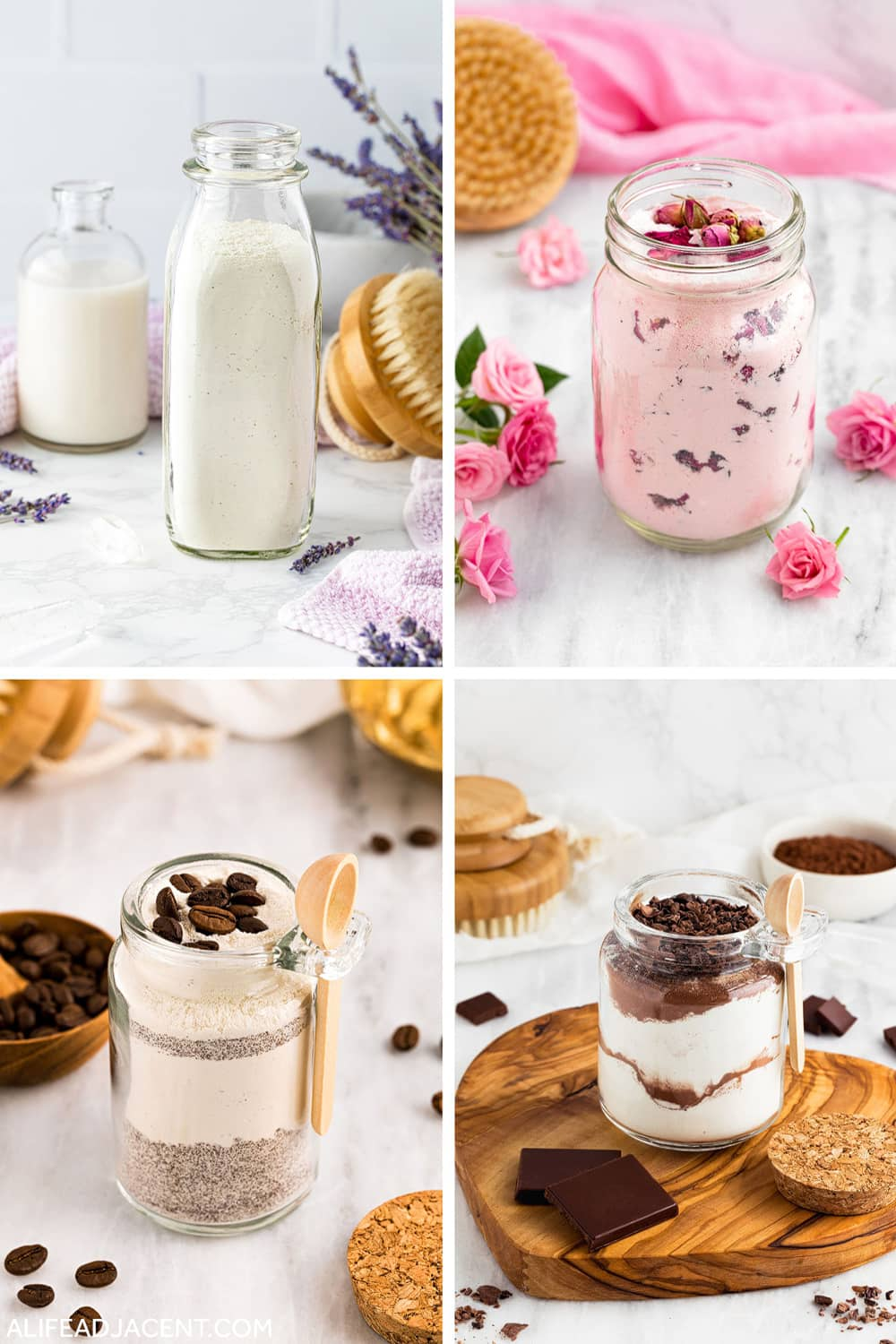
I’m sure you’ve heard of the legend of Cleopatra and her milk bath ritual. Allegedly, opulent milk baths were the secret to her smooth skin and glowing complexion. While there may or may not be truth to this often shared folklore, milk baths do have abundant skin benefits.
Whenever I’m having a particularly stressful day, or my skin is feeling dry or irritated, I find that a relaxing bath with milk powder can help calm my skin as well as relax my mind and body.
In this article, I will show you how to make a simple milk bath recipe with easily accessible ingredients. You’ll also find a selection of essential oil blends for your milk bath, as well as ways to customize your recipe with herbs, flowers, and other additions to suit your particular needs.
For instance, there is a lavender milk bath that can help you get a more restful sleep, a rose milk bath to soothe the skin and senses, and a decadent milk chocolate bath for self-care.
And, if your goal is to relieve minor muscle aches, try the milk bath with essential oils such as eucalyptus and Western peppermint. Finally, even if you don’t take baths, you can also use these recipes to create a nourishing milk foot bath to quickly soften dry heels or callouses.
With only a handful of natural ingredients, you can create a milk bath that’s just as luxurious (and much less expensive) than store-bought bath soaks. So hopefully, after reading this article and learning a little bit about the benefits of milk for your skin, you’re going to want to try bathing in milk for yourself.
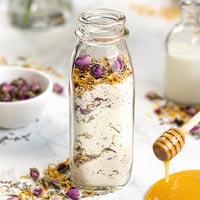
What is a milk bath?
A milk bath is exactly what you would imagine: a bath containing milk. Homemade milk baths may include milk in any format, from full fat milk powder to canned or fresh milk.
If desired, you can also add other bath additives, such as dried flowers, herbs, essential oils, or bath salts.
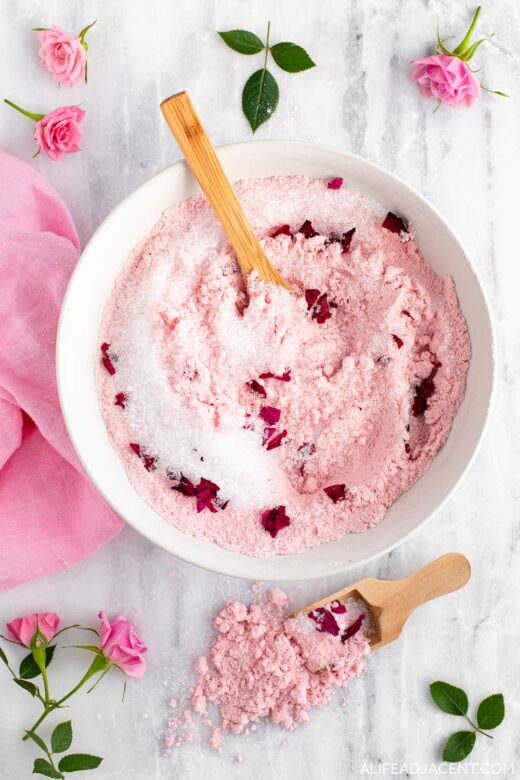
Milk bath benefits
We all know a good soak’s ability to soothe and revitalize the mind, body, and soul, and a milk bath can be a wonderful way to unwind and pamper yourself at the end of a long day.
Immersing in warm, milky bath water promotes feelings of calmness, well-being, and rejuvenation. Taking a milk bath may also help relieve sore muscles or ease headache or migraine pain, and it can also help you fall asleep faster, especially if you add an essential oil blend with lavender oil to your bath water.
But you could also take a Himalayan salt bath or green tea bath for these benefits as well. What sets a milk bath apart from other natural bath recipes is its unique ability to leave skin soft and supple.
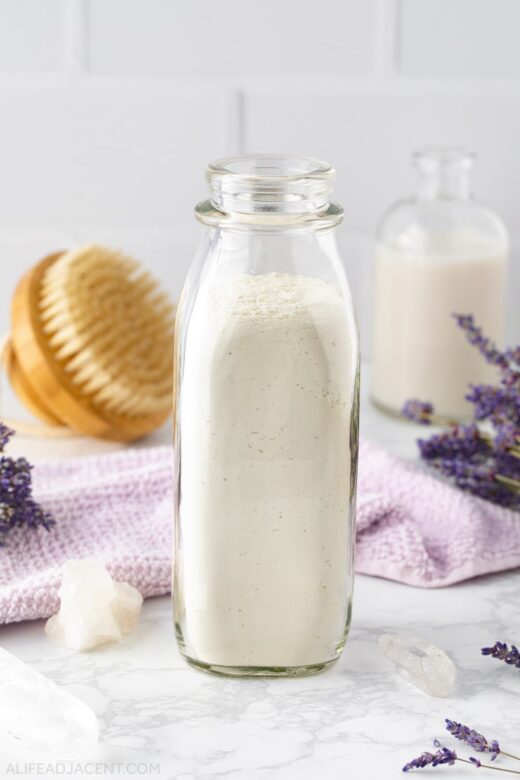
Milk bath benefits for skin
Milk’s skin-softening, nourishing properties can help moisturize and soften dry, irritated, or sensitive skin. In fact, milk baths are known to help soothe itchy skin caused by inflammatory skin conditions such as eczema, rosacea or psoriasis.
They can also provide some relief after a sunburn, bug bite other minor inflammatory skin issue. (However, you should speak with your doctor or naturopath before using a milk bath or other home remedy to treat a skin condition.)
Why milk baths are good for your skin
Of all the natural ingredients to bathe in, what makes a milk bath so beneficial for dry skin?
Milk fat contains approximately 400 different fatty acids, which make it the most complex of all natural fats1. It’s high in cholesterol, which is an important building block of the skin barrier, and it’s also particularly rich in palmitic acid, myristic acid, and stearic acid.
These saturated fatty acids are very emollient, nourishing and skin-protective. They help bolster the skin barrier and reduce epidermal water loss, and they’re also heat-stable, so they won’t be damaged by hot bath water. And after your soak, these nourishing lipids create a barrier on your skin that locks in moisture long after you exit the tub.
Finally, you also get the added benefit of milk protein by bathing in milk, and proteins are the building blocks of healthy skin. In cosmetics, milk protein is associated with moisturizing, protective, anti-irritation, soothing, and anti-aging effects2.
Now, let’s get into how to take a milk bath to learn how to reap the benefits.
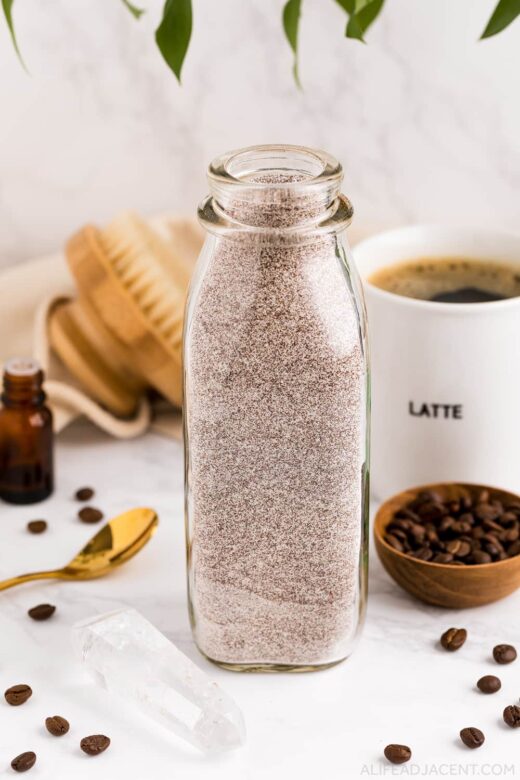
Basic homemade milk bath
For the simplest recipe, whole milk powder, a sprinkle of colloidal oatmeal, a natural emulsifier and essential oils is all you will need to take a milk bath. My basic recipe contains vanilla essential oil for a soothing vanilla milk bath.
You’ll find the basic recipe below, and after, a section with more ways to customize your milk bath with essential oil blends and botanicals. Below the recipe, you’ll also find more information about each ingredient and options for substitutions.
Those with extra sensitive or allergy prone skin may want to omit the essential oils altogether. Because you can still enjoy the skin benefits of a milk bath without essential oils.
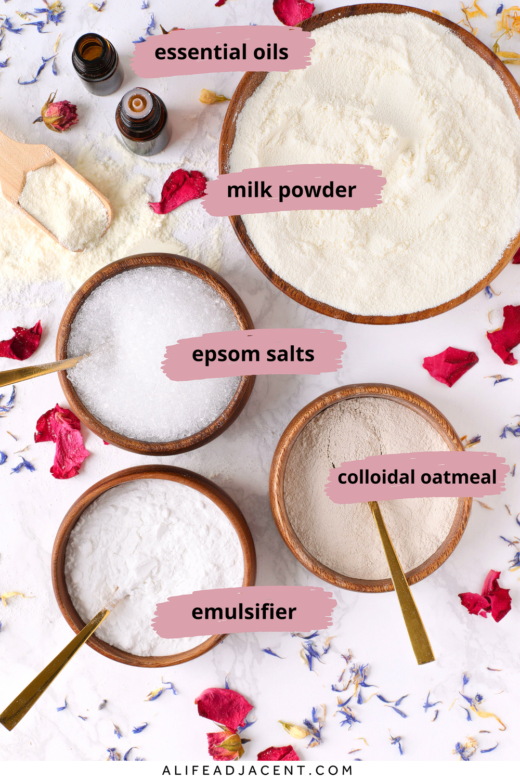
Milk Bath Recipe
3 1/4 cups full-fat milk powder, goat’s milk powder, or coconut milk powder
3/4 cup colloidal oatmeal powder (or honey powder)
1 cup Epsom salts
1/2 cup Natrasorb Bath starch
75 drops vanilla essential oil (more essential oil blends below)
1/2 cup optional mix-ins such as dried flowers or herbs (options below)
Supplies
Large glass or ceramic mixing bowl
Another small mixing bowl
Wooden spoon or spatula
Bath soak storage containers, such as large mason jars or milk bottles
How to make a milk bath
- In a large mixing bowl, combine all dry ingredients except Natrasorb Bath starch: milk powder, colloidal oatmeal powder, and Epsom salts. Mix well with a wooden spoon.
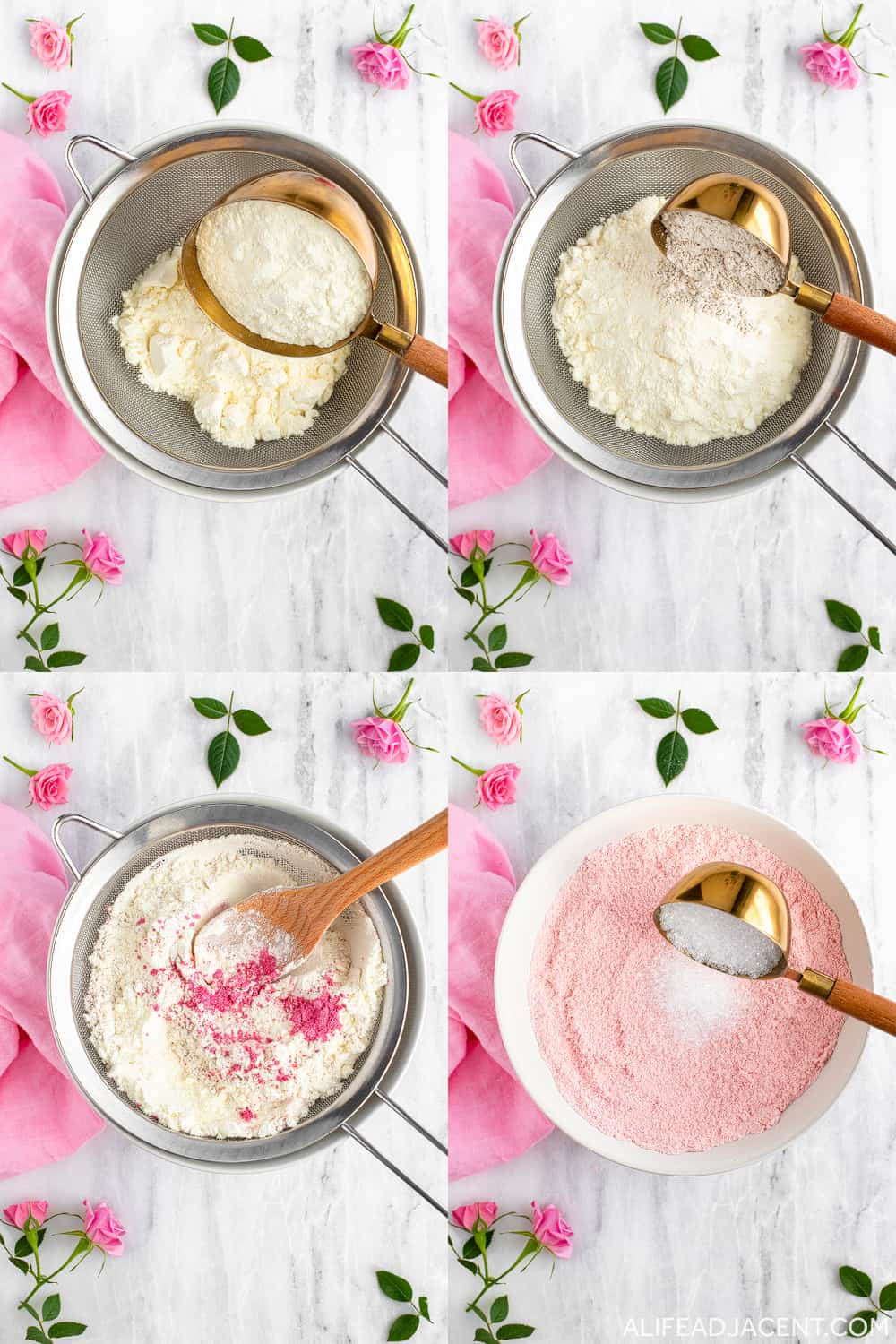
- Place Natrasorb Bath emulsifier starch into a separate, smaller bowl. Sprinkle the essential oils over the starch, then mix well until the oils are completely enveloped in the starch.
Pour this emulsified essential oil starch blend into the rest of your homemade milk bath ingredients. Mix well to incorporate all ingredients evenly.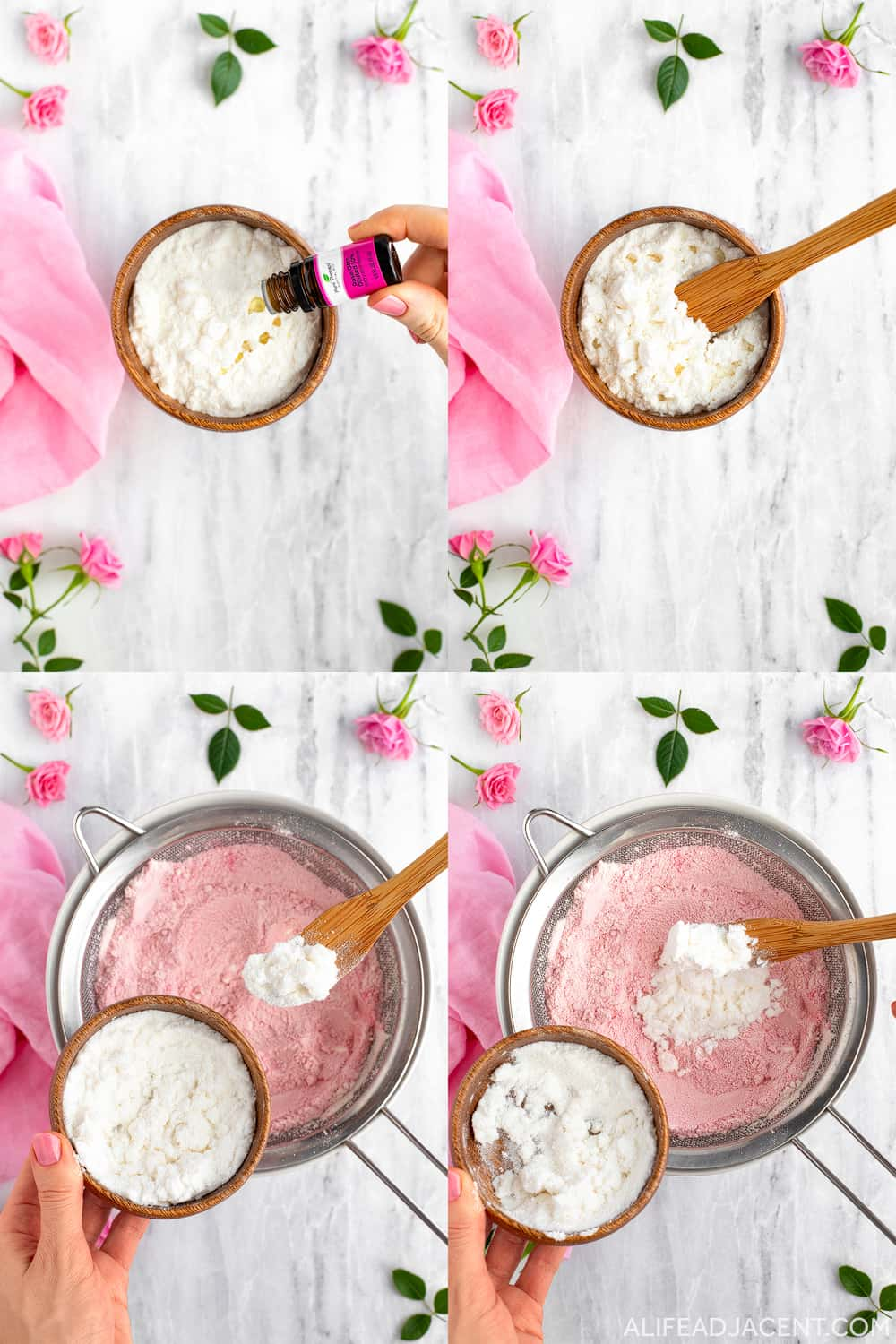
- Finally, add any extras, such as flower petals or herbs. You may mix lightly to spread the botanicals evenly, or another idea is to place them on top or layer them.
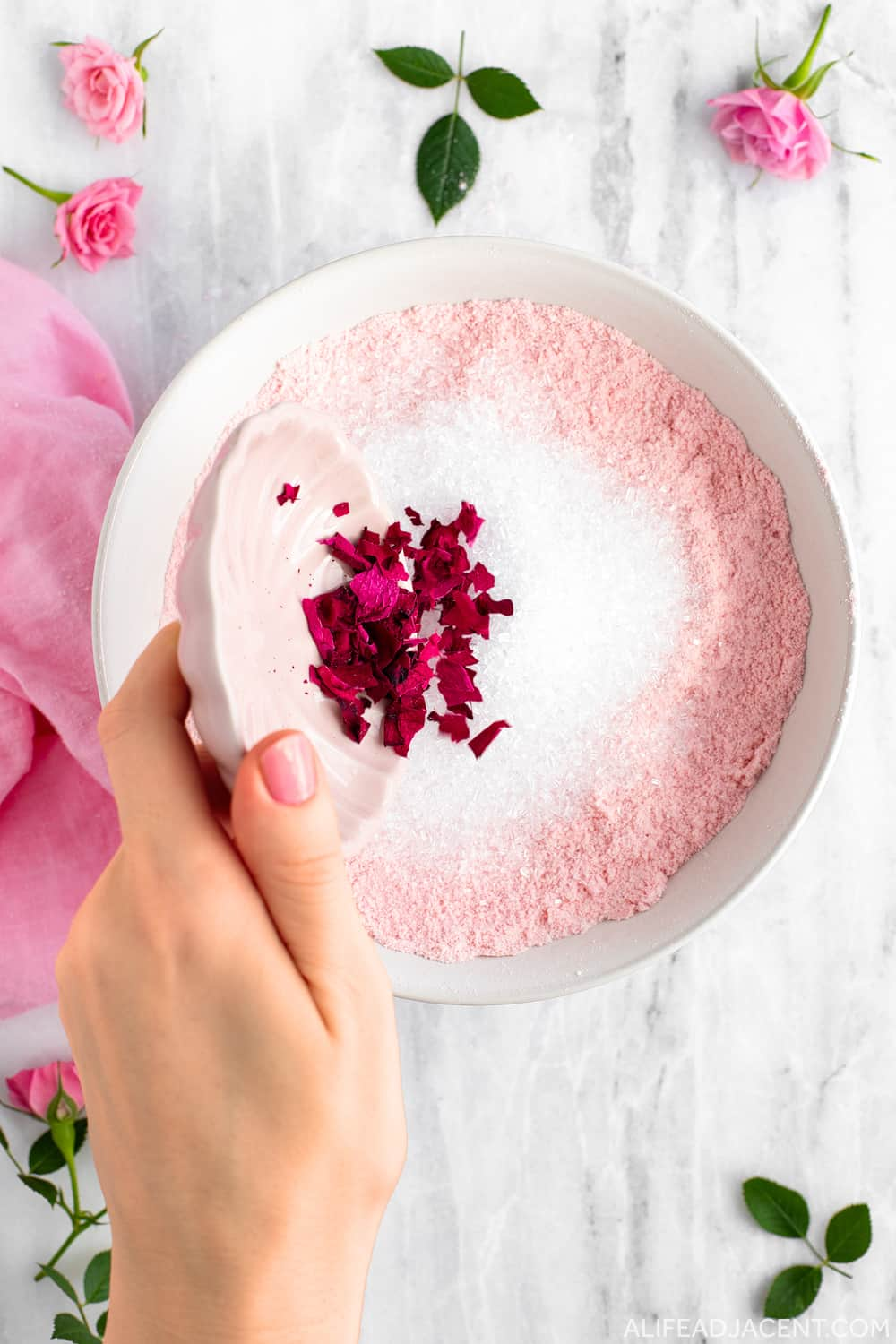

- Transfer your finished milk bath recipe to a large, airtight container with a lid such as a large mason jar or several milk bottles. See suggestions in the section on packaging salt baths below.
- To take a milk bath at home, place 2 cups of homemade milk bath in warm bath water. Swirl to mix and enjoy a luxurious, moisturizing soak, allowing the milk to soften your skin for approximately 20-30 mins. Gently pat skin dry, and follow with a moisturizing body butter or cream to lock in moisture.
How to customize your milk bath recipe
There are a variety of ways to customize your milk bath. You’ll find essential oil blends and mix-ins below to create a few different bath ideas, including a lavender milk bath for sleep, a peppermint milk bath for pain relief, and a romantic rose chocolate milk bath for self-care.
Lavender Milk Bath
30 drops lavender essential oil
45 drops vanilla botanical extract
1/2 cup dried lavender buds or blue cornflower petals (optional)
The soothing aroma of lavender promotes sleep and relaxation. Use lavender essential oil in your milk bath if your goal is to encourage restful slumber.

Rose Milk Bath
30 drops rose absolute or rose geranium essential oil
45 drops vanilla botanical extract
1/2 cup red or pink dried rose petals (or rosebuds)
The luxurious fragrance of roses is an opulent addition to a homemade milk soak, inducing feelings of well-being, romance, and love.
A sprinkle of rose petals adds beauty and more fragrance to this blend, while vanilla essential oil adds sweetness.
The price of rose oil can be high. Rose absolute is a more inexpensive alternative, and rose geranium essential oil is even more affordable.
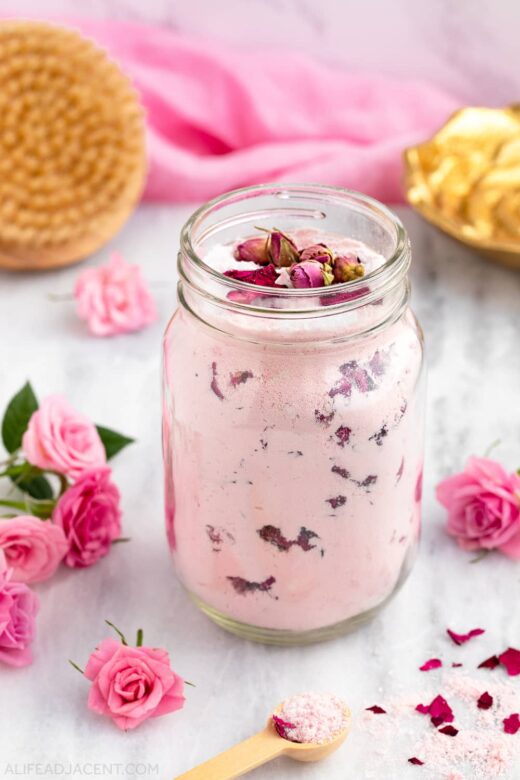
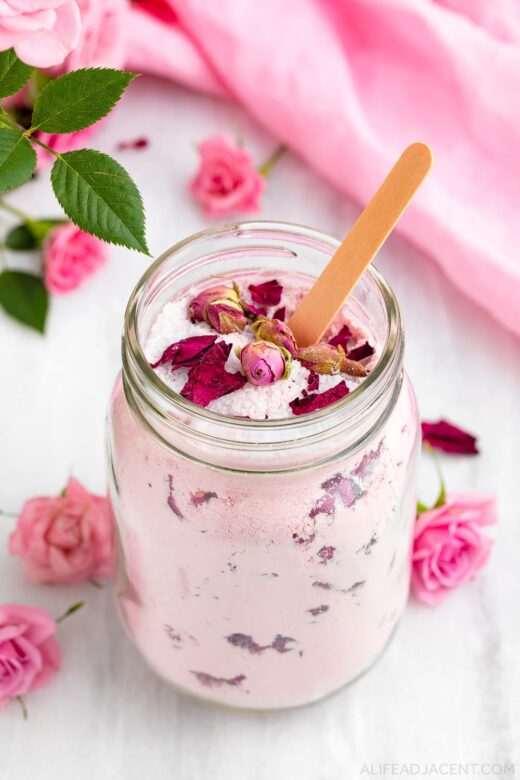
Hot Chocolate Milk Bath
30 drops chocolate truffle essential oil
40 drops vanilla botanical extract
1/4 cup cacao husk tea or cacao nibs
1/4 cup cocoa powder
Have you ever wanted to bathe in hot chocolate? Real chocolate essential oil and cacao tea pieces add decadent chocolate fragrance and luxury to this milk bath blend, making your bathwater feel like a mug of milky hot cocoa.
If you’re a rose lover, combine the rose and chocolate blends for a chocolate rose bath.
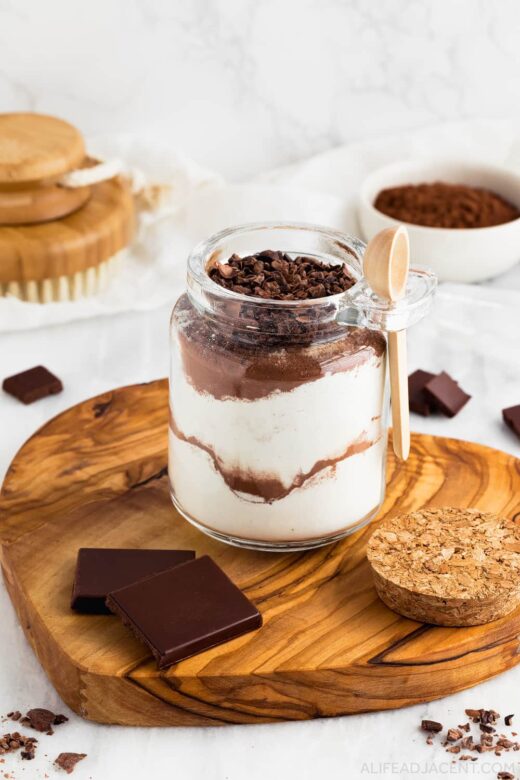
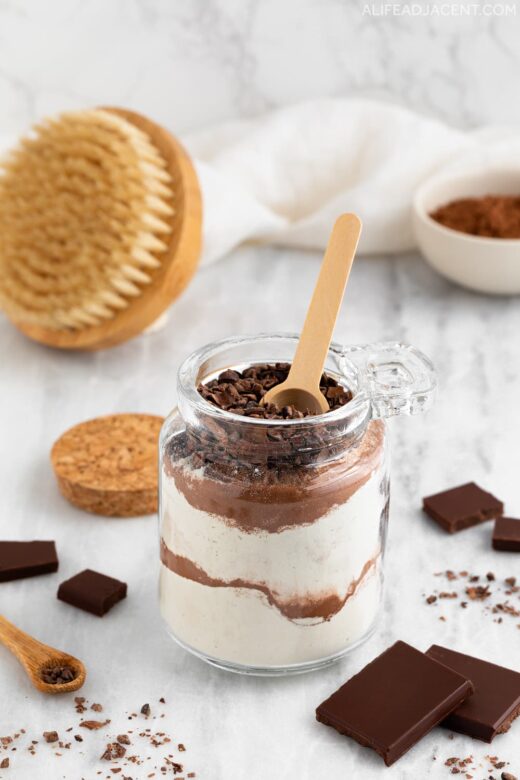
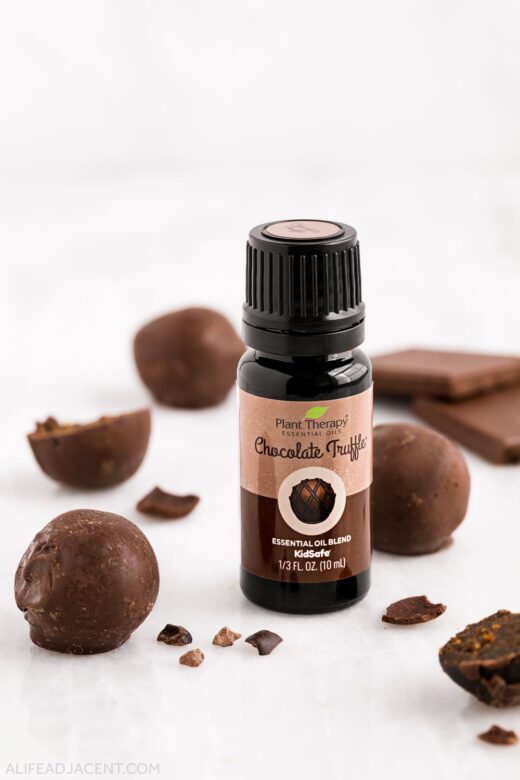
Peppermint Milk Bath
20 drops Western peppermint essential oil
20 drops eucalyptus essential oil
20 drops vanilla botanical extract or vanilla oleoresin
1/2 cup dried peppermint leaves or eucalyptus
If sore muscles, tension, or chronic pain have got you down, you can combine a milk bath’s moisturizing effects with the pain-relieving properties of peppermint and eucalyptus essential oils.
If you’re feeling under the weather, these oils also act as natural decongestants which may help you breathe easier and feel better faster. As an added benefit, peppermint and eucalyptus oil’s natural deodorizing properties make them ideal oils to add to a milk foot bath.
You can use regular peppermint oil, or opt for Western peppermint oil for a stronger dose of menthol and pain-relieving properties.
Chocolate mint lover? Combine this recipe with the chocolate blend for a milk bath that’s like peppermint hot chocolate.
Coffee Milk Bath
40 drops coffee essential oil
30 drops vanilla oleoresin or vanilla botanical extract
1/2 cup instant coffee powder
Inspired by our coffee bath bombs, this caffeinated milk bath recipe is like taking a bath in your latte. With real coffee powder and coffee essential oil, this bath soak will energize you while it softens your skin.

Milk bath ingredients
Below you’ll find more information on milk bath ingredients, substitutions, and further ways to customize a moisturizing milk bath.
Full-fat, organic powdered milk
Organic milk powder or goats milk powder are the best choices for a milk bath recipe. You want to make sure the milk is full fat to reap all the glorious benefits of those nourishing saturated fatty acids. Skimmed milk powder or buttermilk powder, while high in proteins, won’t be as effective for skin softening.
For vegans or those allergic to dairy, you can substitute coconut milk powder in this recipe. While not the same as dairy fat, coconuts are rich in other saturated fatty acids with their own skin-nourishing properties.
Colloidal oatmeal
You may already be aware that colloidal oatmeal is commonly used as a natural remedy for eczema to calm dry itchy skin. I added oatmeal to this milk bath recipe for its powerful soothing and anti-inflammatory properties.
Studies have backed up its effectiveness and ability to soothe the skin and calm minor rashes3, and colloidal oatmeal can also be used to add extra moisturizing properties to your bath.
You can buy pre-made colloidal oatmeal for your bath or simply make your own. Using a processor, blend whole oats (organic preferably) until they resemble fine powder. But if you want to omit it, you can still take a milk bath without oatmeal.
Epsom salt
A common staple in homemade baths, Epsom salts add extra calming, relaxing effects to any soak. We recently shared a pink salt bath recipe if you want to try adding another type of salt to your bath.
Natrasorb Bath (bath soak emulsifier)
A natural emulsifier is important whenever you add essential oils to a homemade bath. Otherwise, the undiluted essential oils will pool on the surface of your bath water, which can potentially cause skin rashes.
I used Natrasorb Bath starch to disperse the oils in these milk baths. It’s a specially modified natural tapioca starch that absorbs and disperses large amounts of essential oils with ease. It’s also excellent for use in bath bombs and other bath soak recipes.
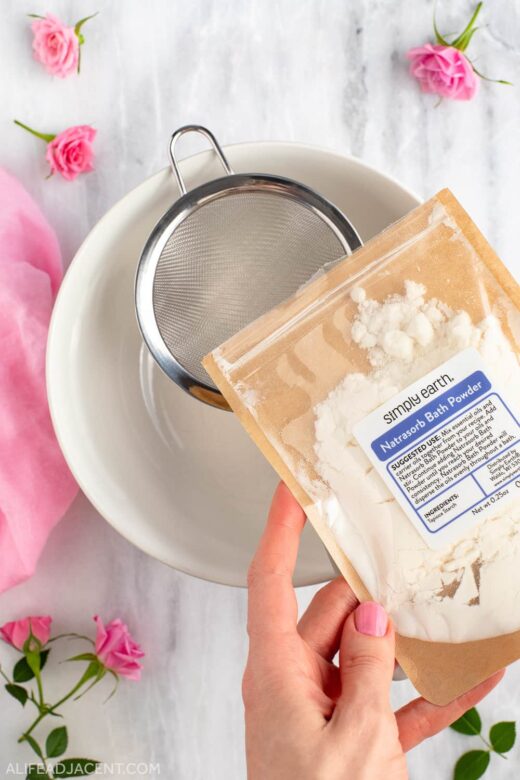
Herbs or dried flowers
Dried flowers or herbs can be added to these milk baths, especially if you plan to gift these recipes. My favorites include organic rose petals, white jasmine flowers, calendula, dried lavender or blue cornflowers.
Honey powder (optional)
If your skin is particularly dry, honey powder is an optional and luxurious addition to your milk bath. Its humectant properties bind and attract water, making your milk bath even more moisturizing, and it also gives bath water a silky, luxurious feel.
Since it’s a powder, you won’t have to worry about your homemade bath soak expiring or growing mold! For more information on using powdered honey, you can read my separate milk and honey bath recipe.
Milk Bath FAQ
How much does this milk bath make?
Each recipe makes approximately 6 cups of bath soak, which is enough for 3 milk baths.
This means you can store the entire milk bath batch in a large 2 litre jar, or separate it into multiple smaller jars, such as 3 small 500ml milk bottles.
How to store and package milk bath
Milk powder is extremely hygroscopic, so your milk bath it will absorb moisture and spoil if left exposed to air. It’s vital to keep it in a sealed container with an airtight lid in a cool, dry place. A dark cupboard works best, as light will also degrade the ingredients.
You can use repurposed milk bottles such as the ones shown in the photos as long as they have an air tight lid. Mason jars with spring or screw top lids, or glass test tubes. For more bath soak packaging ideas:
How long does a milk bath last?
Your milk bath’s shelf-life depends on the expiry date of your milk powder, so check the label.
Overall, when the ingredients are fresh, and when stored correctly, this milk bath recipe should last about 6 months.
Will a milk bath clog the drain?
When using a milk bath or any homemade bath soak with added botanicals or flower petals, be sure to pick out the plant matter before draining your bathtub to avoid clogged drains.
Alternatively, you can use place your milk bath into an unbleached cotton or muslin bag before placing it into the tub, or simply use a drain cover.
How to make a milk foot soak
A milk bath can also soften your feet and even help combat foot odor. So if you dislike baths (some people do!) then you might want to use this recipe as a nourishing foot soak instead.
To make a milk bath for your feet, dissolve 1/2 cup of milk bath in a basin filled with enough warm water to submerge your feet. Unwind for about 15-20 minutes.
Pat your feet dry and then apply a thick body butter to lock in moisture. Then put on some cozy socks — 100% organic cotton is best.
What kind of milk should you use for a milk bath?
Technically, any kind of milk will work for a milk bath, but there’s a little bit more to it than that. So what are the benefits of using a homemade milk bath over simply bathing in fresh milk?
The most obvious benefit is that milk powder is more concentrated. While fresh milk is up to 87% water, the liquid in powdered milk has been evaporated. This makes milk powder higher in proteins and lipids per gram than fresh milk – which is all of that skin nourishing goodness that we want in a milk bath.
Not only does this mean a bath with milk powder is less expensive, it’s also just easier and more effective. Sure, you could add a litre of fresh milk to your bath for an extra luxurious soak, but it’s much more economical to add a cup or two of powdered milk (and save your good organic milk for your latte).
Can you use fresh milk?
Yes, if you don’t have access to powdered milk, you can use fresh milk, evaporated milk, or canned coconut milk in a milk bath. Warm fresh milk on the stove before adding it to your bath water, and place it in a heat-safe receptacle such as a glass teapot for safe carrying to your bath.
Does a milk bath exfoliate your skin?
Milk contains latic acid, which is often touted for its exfoliating properties. However, acids require a low pH and acidic environment to do their job. Lactic acid in a milk bath will not exfoliate or help slough off dry skin, they it will act as a humectant to help moisturize and soften.
Why didn’t I add baking soda to this milk bath?
Baking soda (sodium bicarbonate) is common in milk bath recipes, as some find it helps calms irritated skin and naturally reduces itchiness.
However, baking soda is alkaline, and our skin’s pH is mildly acid. Depending on your skin’s condition, an alkaline bath with baking soda may disrupt your skin’s pH level and further irritate your skin.
If you have skin issues such as eczema, psoriasis, or hives you can ask your health professional if a milk bath with added baking soda could be beneficial for your skin.
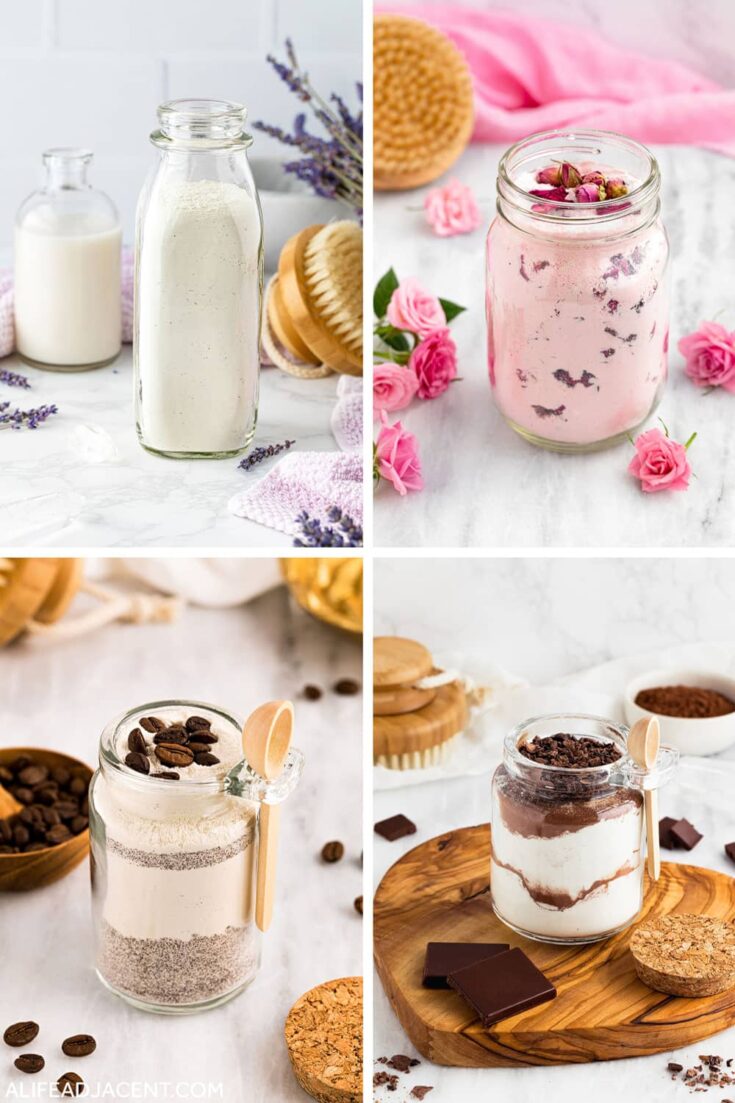
Milk Bath Recipe: Lavender, Rose, Coffee & Chocolate
Discover 6 milk bath recipes for soft skin, including rose, lavender, coffee, and chocolate milk bath. Chock full of natural ingredients, this luxurious homemade bath soak made with full fat milk is not only easy to prepare, but it’s a wonderful way to indulge in some much needed self-care.
Ingredients
Basic Milk Bath
- 3 1/4 cups full-fat milk powder or coconut milk powder
- 3/4 cup colloidal oatmeal powder (or honey powder)
- 1 cup Epsom salts
- 1/2 cup Natrasorb Bath starch
- 75 drops vanilla botanical extract (more essential oil blends below)
- 1/2 cup optional mix-ins such as dried flowers or herbs (options below)
Rose Milk Bath
- 30 drops rose absolute or rose geranium essential oil
- 45 drops vanilla botanical extract
- 1/2 cup red or pink dried rose petals (or rosebuds)
Hot Chocolate Milk Bath
- 30 drops chocolate essential oil
- 40 drops vanilla botanical extract
- 1/4 cup cacao husk tea or cacao nibs
- 1/4 cup cocoa powder
Peppermint Milk Bath
- 20 drops Western peppermint essential oil
- 20 drops eucalyptus essential oil
- 20 drops vanilla botanical extract or vanilla oleoresin
- 1/2 cup dried peppermint leaves or eucalyptus
Coffee Milk Bath
- 40 drops coffee essential oil
- 30 drops vanilla oleoresin or vanilla botanical extract
- 1/2 cup instant coffee powder
Supplies
- Large glass or ceramic mixing bowl
- Smaller mixing bowl
- Wooden spoon or spatula
- Mason jars or milk bottles for storage
Instructions
- In a large mixing bowl, combine all dry ingredients except Natrasorb Bath starch: milk powder, colloidal oatmeal powder, and Epsom salts. Mix well with a wooden spoon.
- Place Natrasorb Bath emulsifier starch into a separate, smaller bowl. Sprinkle the essential oils over the starch, then mix well until the oils are completely enveloped in the starch.
Pour this emulsified essential oil starch blend into the rest of your homemade milk bath ingredients. Mix well to incorporate all ingredients evenly. - Finally, add any extras, such as flower petals or herbs. You may mix lightly to spread the botanicals evenly, or another idea is to place them on top or layer them.
- Transfer your finished milk bath recipe to a large, airtight container with a lid such as a large mason jar or several milk bottles. See suggestions in the section on packaging salt baths below.
- To take a milk bath at home, place 2 cups of homemade milk bath in warm bath water. Swirl to mix and enjoy a luxurious, moisturizing soak, allowing the milk to soften your skin for approximately 20-30 mins. Gently pat skin dry, and follow with a moisturizing body butter or cream to lock in moisture.
More natural bath recipes
If you enjoyed this tutorial, you may also like our other bath recipes:
- Milk and Honey Bath
- Pink Salt Bath Recipe
- Green Tea Bath
- Pink Lemonade Tub Tea
- Homemade Floral Bath Salts
- Pumpkin Spice Bath Salts
- Chocolate and Roses Bath Tea
For even more natural bath and body recipes, follow us on Pinterest! You can also find us on Instagram, Facebook, TikTok, and Twitter.
📌 Pin it for later

